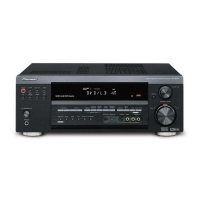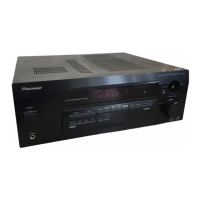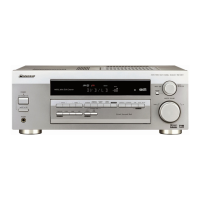Do you have a question about the Pioneer VSX-D1011-K and is the answer not in the manual?
Crucial safety warnings and precautions for operating the audio receiver.
Guidance on installing the receiver, ensuring proper ventilation for heat dissipation.
Instructions for setting voltage selectors on multi-voltage models based on region.
Recommended temperature, humidity, and location for optimal unit performance.
Details the advanced audio architecture for multichannel sound reproduction.
Explains the automatic speaker setup system for optimal surround sound.
Lists supported Dolby Digital, DTS, and video formats for home theater.
Compatibility with DVD-Audio and Super Audio CD (SACD) players.
Highlights the remote control's user-friendly design and multi-component operation.
Information on the unit's low power consumption in standby mode.
List of all supplied accessories to check upon receiving the product.
Instructions for preparing the remote control, including battery installation.
Information on the effective range and conditions for remote control operation.
Specific warnings regarding unit installation to ensure proper heat dispersal.
Instructions for connecting the TV to the receiver using video cables.
Connecting video sources like DVD players, VCRs, and satellite tuners.
Connecting analog audio sources like turntables and cassette decks.
Connecting digital audio sources like CD recorders and players.
Connecting FM and AM antennas for radio reception.
Instructions for connecting front, center, surround, and back speakers.
How to adjust the receiver's impedance setting for different speakers.
Recommendations for optimal speaker placement for surround sound effect.
Explains all illuminated indicators on the receiver's display for various functions.
Detailed explanation of the functions of buttons and dials on the front panel.
Detailed description of each button on the remote control and its function.
Configuring the use of surround back speakers (Normal, Second Zone, Bi-Amp).
A simplified procedure for quickly adjusting speaker settings for surround sound.
Manual method for adjusting sound parameters like speaker set and levels.
Balancing the sound output level of individual speakers for realistic surround sound.
Adjusting speaker delay for sound depth, separation, and effect.
Instructions on how to play sound sources and adjust volume.
Selecting between analog and digital input signals for optimal playback.
Overview of available listening modes (Stereo, Direct, Movie, Music).
Details on movie-specific listening modes like THX Cinema and Pro Logic.
Details on music-specific listening modes like Classical, Jazz, and Rock.
Adjusting the amount of effect in DSP modes and Pro Logic II Music.
Using the Acoustic Calibration EQ feature for room equalization.
Enabling Digital Noise Reduction to reduce background noise.
Enhancing surround sound at low volumes with Midnight and Loudness modes.
Adjusting bass and treble frequencies and bypassing tone circuitry.
Enhancing dynamic range for finer audio reproduction with Hi-Bit/Sampling.
Connecting DVD-Audio players or external decoders for multichannel playback.
Controlling surround back channels and virtual surround modes.
Using dual mono sources and connecting headphones for private listening.
Selecting video sources independently and adjusting display brightness.
Tuning FM and AM radio broadcasts using automatic and manual methods.
Adjusting tuning increments and tuning directly to specific frequencies.
Saving favorite stations and assigning custom names for easy recall.
Understanding Radio Data System (RDS) and EON for program information and searches.
Programming the remote control to operate other audio/video components.
Programming the remote by learning commands from other remote controls.
Remote control operations for CD, MD, VCR, DVD, LD players and recorders.
Remote control operations for Cable TV, Satellite TV, and regular TV sets.
Configuring direct function for external video decks not passing through receiver.
How to make recordings from one component to another via the receiver.
Setting up stereo playback in another room or bi-amping front speakers.
Switching between speaker systems A, B, or both, depending on setup.
Connecting additional amplifiers to power speakers for enhanced audio.
Programming sequences of commands and setting up a one-button power-off.
Operating other Pioneer components via receiver's control out terminal.
Advanced settings like THX Cinema, Input Assign, and Function Rename.
Choosing multichannel decoding methods for THX Cinema sources.
Mapping digital inputs to specific components when default settings are not used.
Renaming function displays on the receiver for connected components.
Determining the frequency cutoff point for the subwoofer or large speakers.
Precisely balancing speaker output levels using test tones.
Fine-tuning speaker delay for improved sound depth and separation.
Adjusting speaker equalization based on room acoustics using test tones.
Setting the peak level for the LFE channel to prevent bass distortion.
Compressing dynamic range for enhanced surround sound at low volumes.
Explanations of Dolby Digital, Dolby Surround, and Dolby Pro Logic II technologies.
Details on Dolby Digital Surround EX technology for 6.1 channel sound.
Explanations of DTS, DTS-ES, DTS Neo:6, and DTS 96/24 formats.
Explanations of THX, Re-Equalization, Adaptive Decorrelation, Timbre Matching.
Guidelines for speaker placement, direction, angle, and distance for surround sound.
Specific speaker placement diagrams for THX systems and multichannel audio sources.
List of preset codes for controlling various brands of DVD, LD, TV, VCR, MD, STB, Tape.
Common problems and their remedies related to power, unit response, and audio output.











